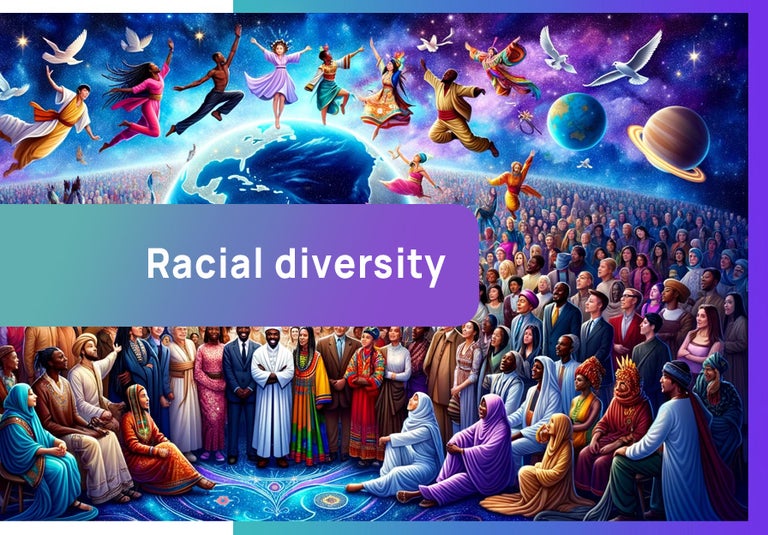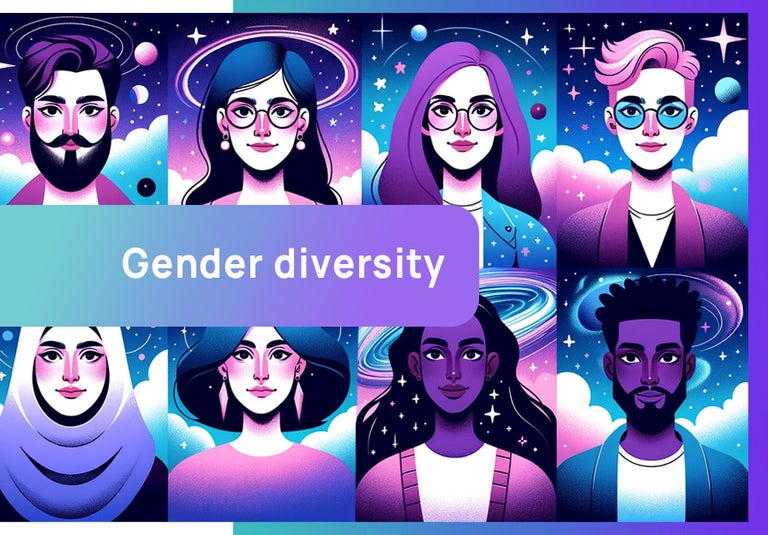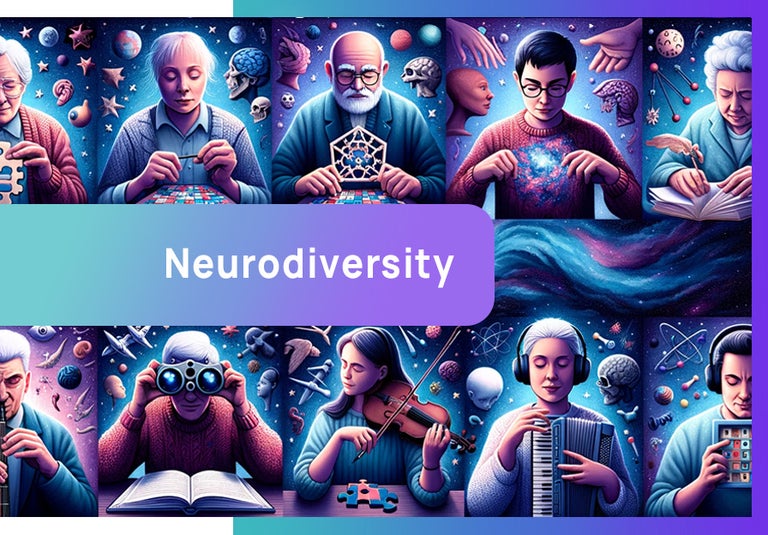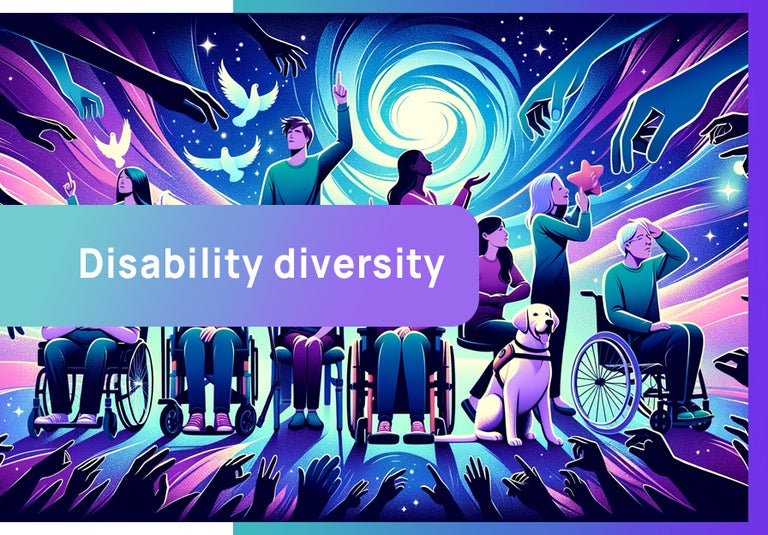Contents
- Wait: Is Remote Work Good for DEI?
- The Future is Everyone, Everywhere
- 1) Racial Diversity
- 2) Gender Diversity
- 3) Age Diversity
- 4) Neurodiversity
- 5) Disability Diversity
- 6) LGBTQIA+ Diversity
- 7) Global Diversity
- Crossover’s Global Mission: Remote Work Diversity and Inclusion
Does remote work promote diversity and inclusion? Short answer: yes, and every workplace should be embracing it.
It’s October and that means it’s global diversity awareness month!
In honor of DEI October, I’m outlining a vision of the future that brings remote work and diversity together.
Let’s imagine what could happen if we allow remote work to become an essential part of every workplace.
Teams from everywhere will work together to build the next generation of products, services and solutions.
Anyone, no matter who they are, what they look like, or where they’re from - can rise to the highest peak.
And by ‘highest peak’ we mean lockdown the best US tech jobs!
The future we’re fighting for is globally diverse.
Wait: Is Remote Work Good for DEI?
Workplace diversity and inclusion is good for business.
- This 2018 study proved that diverse teams generate 19% more revenue
- 70% of job seekers are swayed by a company’s diversity commitment
- According to Deloitte diversity improves retention and lowers turnover
Not only does DEI boost business, attract the best people, and keep them in your company – it also unlocks innovation and drives market growth. Who wouldn’t want in?
Here’s the twist.
Though remote work has a MASSIVE multiplying effect on diversity and inclusion – both inherent and acquired – the tech world has other priorities.
In our opinion that’s a bad move.
The Future is Everyone, Everywhere
I recently rewatched the smash hit ‘Everything Everywhere All at Once’ with the incomparable Michelle Yeoh – who won Best Actress for this role at the Oscars.
In case you missed it, it’s about a woman who has to save existence by exploring lives she’s lived in other dimensions. This multiverse of opportunity shows her that she could have done anything, been anything she wanted. That her choices made her reality.
And I can’t help feeling that way about remote work and diversity. If allowed to co-exist to their maximum potential, we could solve a large majority of global DEI workplace issues.
I believe that the future of hiring is everyone, everywhere.
Let’s take a sneak peek at the different dimensions of diversity and what they could be if the world fully embraces remote working as an everyday part of modern workplace culture.
1) Racial Diversity
The pandemic proved that offices were not the safe spaces many DEI representatives had hoped for. Studies showed that people of color who worked remotely were more comfortable than office-bound workers.
The University of California at Hastings researchers found:
- 64% of people of color could manage stress better at home
- 50% felt increased feelings of belonging

The Remote Future:
- Remote work reduces a person of color’s likelihood of being discriminated against.
Comfort, productivity and belonging are priorities, so everyone is given the option to work remotely or not. For people of color, this means having the ability to work from anywhere in an environment that suits them.
Remote working means the likelihood of overt discrimination, harassment, microaggressions and unintended bias are significantly reduced.
Over time this amounts to increased psychological and emotional safety – and happier employees that remain engaged at work.
2) Gender Diversity
Remote work frees women from unreasonable and inflexible workdays.
Suddenly it was possible to be a mom and work an 8 hour a day job.
Offices have historically forced women out, simply because of their rigid nature. For gender diversity, that meant more women working full time.
More women apply for remote roles than men do. And that’s because all over the world, women tend to be the family caregivers.

The Remote Future:
- Remote work prioritizes the unique needs of women – and the modern family unit.
Women working remotely help close the gender pay gap. It’s easier for them to advance in their careers because work-life balance can be managed without having to take absences.
That means faster promotions and more women in leadership over time.
The impact of this would be better quality of life for families, greater professional achievement for women, and better business results across the board.
More products would be designed with women in mind and the world would improve for more than half of its population.
3) Age Diversity
These days most remote workers are between 24-35 years old.
Surprisingly older adults would benefit more from remote work. Some 64% of US companies have DEI strategies, but only 8% include age diversity.
Tech specifically, is extremely ageist. People over fifty, regardless of the career they had, are often discriminated against and are treated unfairly in office environments.

The Remote Future
- Remote work helps older people get hired more often.
The ‘ageless’ workplace is realized with remote, which favors skills over superficial and outdated signals that have been thought to predict job performance. This invites critical perspectives to new initiatives, and provides mentors for trainees.
As older people are hired more, invaluable experience will help guide tech teams and influence better decision making.
Careers won’t be derailed as often, and less people will fear the repercussions of getting older in tech. Because of this, the business world stands to benefit from age-related products and services from a talent pool of valid, equal and highly valuable candidates.
4) Neurodiversity
Not everyone experiences the world in the same way.
It’s estimated that a whopping 10-20% of people are neurodivergent.
There’s a typical way for a brain to function, and a divergent way too. Because office workplaces are built for neurotypical people, they can be extremely uncomfortable places for the segment of the population who aren’t.
It’s not uncommon for neurodiverse individuals to be discriminated against, especially by hiring managers.
And traditionally there has been an unwillingness to adapt workflows and workspaces to accommodate neurodiverse people at the office.
Some neurodivergent folks include Steve Jobs, Emma Watson and Einstein.

The Remote Future:
- Remote work gives neurodiverse people the ability to be their best.
Neurodiverse individuals can pick where they work, whether it's at home or a place they love. This means they're always at their best, connecting and teaming up with colleagues in meaningful ways.
Asynchronous remote work frees them from being bound by typical time constraints, workflows and bureaucracy.
This means that they can delve deeper into their work, exploring new ideas, creating innovations and contributing to the team in fresh and dynamic ways.
The freedom to decide how and when to communicate respects everyone's unique way of learning and problem-solving.
Neurodivergent individuals can better challenge the status quo, facilitate growth and drive creativity without limitation.
By having control over their work style, they’ll supercharge any team they’re on.
5) Disability Diversity
People with disabilities are often excluded from the modern workplace.
This is because of a stigma that has inaccurately branded ‘difference’ as ‘affliction.’ Instead of seeing employees with disabilities as a group, they are seen as individuals with technical problems that need to be solved.
This has unjustly led to widespread discrimination from hiring managers and team members in office environments.
Before the pandemic, fewer people with disabilities had jobs. But after the rise of remote work, their employment rate shot up to 21.3%.
This shows that when we remove bias, they can thrive. Full time, fully remote work helps this underrepresented group create a better quality of life.

The Remote Future:
- Remote work helps people with disabilities find and keep permanent employment.
No matter the disability, it’s made easier by working remotely. Modern technology and processes mean people will process information in the way that suits them best.
This reduces time spent on accommodations and allows the individual to create a work environment where they can thrive.
Without transportation barriers, accessibility barriers and the mental fatigue of communicating with teams in person – people with a variety of disabilities (sight, sound, movement, processing) can focus on the work at hand.
The reduction in stress, pressure and preparation anxiety gives this group of people the ability to build careers, take on complex challenges, and become leaders at work.
6) LGBTQIA+ Diversity
Traditional workplaces can be minefields for people in the LGBTQIA+ community.
- 46% of LGBTQIA+ workers are closeted at work
- 53% hear jokes about queer people at the office
- 1 in 5 have been told by a coworker to dress in a more masculine or feminine way
The Human Rights Commission believes office environments have a long way to go before inclusion is authentic and sincere.
In countries where being in the LGBTQIA+ community is outlawed or not protected at all – it’s even more difficult to sustain positive relations at work.
Queer women and transgender members of the community are often the hardest hit, and are underrepresented in the top echelons of tech.

The Remote Future
- Remote work helps the queer community stay in safe and supported environments.
LGBTQIA+ people working remotely never have to choose between a safe community and being close to the office again. Because of that, harassment, open discrimination, and isolation are removed as challenges in their careers.
Being psychologically, emotionally and physically safe among their peers fosters feelings of happiness, motivation and supercharges creativity.
Queer people with the freedom to be themselves are more productive, authentic and engaged at work. Plus monitored team environments online will give people the opportunity to get to know their queer colleagues, in ways an office could not.
Because remote work has an overwhelmingly positive impact on wellbeing in this community, their careers explode.
That means more LGBTQIA+ people influencing workplace culture, and contributing diverse perspectives to products, services and solutions that include everyone.
7) Global Diversity
Where a person lives should never influence whether they’re hired or not – but it does.
Remote work has made it possible to hire or be hired from anywhere. Yet many US companies are convinced that it’s too hard, or too complicated to hire overseas. And that’s just not true.
The old obstacles of employment status, tax liability, payroll, compliance and management have all been solved. Crossover does it every day, and by doing it we’re opening our clients up to global talent that’s giving them a big competitive advantage in tech.
- Workers on the clock in different time zones 24/7
- Unique and valuable perspectives that drive innovation
- Next-level cultural competency and collaboration
- A diverse workforce solves problems faster
- Find high performers from across the world to build a super team
- Increase productivity to dizzying heights for your company

The Remote Future is Global
At Crossover, we’re not just about jobs, we’re about stories.
Andrew travels to dozens of different countries every year, to help the people we’ve hired share who they are.
[Watch his Out of Office episodes here]
That level of storytelling brings people together.
It says, “We’re here and we’re waiting for you.”
It’s inclusive because it’s so globally diverse. There’s a fundamental practice of embracing and celebrating differences.
In our opinion that is the best way to find extraordinary talent that can do extraordinary work.
And Crossover believes in talent, not boundaries.
Why should unconscious bias define your shot at the job?
Our entire mission is to close that gap in tech. To eliminate that bias from hiring.
We want to bring global diversity to your team.
Because genius isn’t zip code specific.
Crossover’s Global Mission: Remote Work Diversity and Inclusion
Here’s something you might not know about us!
We don’t discriminate against candidates based on gender, race, cultural background, religion, sexual orientation or gender identity, disability, neurodiversity, age, education or geographic location.
Our hiring process is one of the most unbiased in the world today.
Equality is an uncompromising value at Crossover.
The first month on the job, I saw a list of everyone’s names along with their salaries. It’s 100% transparent and everyone can access that list. That means the company pays any woman working here the same amount as a man doing the same job.
There is no gender pay gap.
Take that concept and multiply it across all forms of pay discrimination.
Picture a world where everyone has the chance to land their dream job and create a brighter future. That's the heart of inclusion: a level playing field for all.
Instead of unconscious bias that blocks diverse candidates from excelling, we ask our candidates from across the world to take the CCAT test. It’s 100% unbiased.
This October – during Global Diversity Awareness Month – think about what your team could achieve if you start putting diversity first.
Teams that champion DEI and its remote strengths will outpace the rest.
As Michelle Yeoh said in her Academy Awards speech: “This is history in the making.”
Everyone. Everywhere. All at once.








